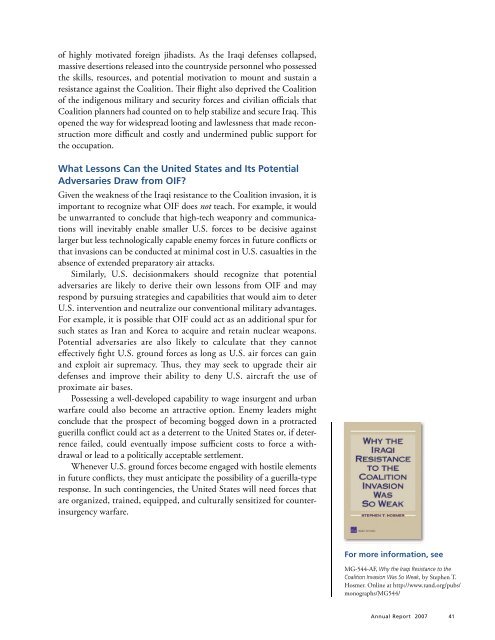RAND Project AIR FORCE Annual Report 2007 - RAND Corporation
RAND Project AIR FORCE Annual Report 2007 - RAND Corporation
RAND Project AIR FORCE Annual Report 2007 - RAND Corporation
Create successful ePaper yourself
Turn your PDF publications into a flip-book with our unique Google optimized e-Paper software.
of highly motivated foreign jihadists. As the Iraqi defenses collapsed,massive desertions released into the countryside personnel who possessedthe skills, resources, and potential motivation to mount and sustain aresistance against the Coalition. Their flight also deprived the Coalitionof the indigenous military and security forces and civilian officials thatCoalition planners had counted on to help stabilize and secure Iraq. Thisopened the way for widespread looting and lawlessness that made reconstructionmore difficult and costly and undermined public support forthe occupation.What Lessons Can the United States and Its PotentialAdversaries Draw from OIF?Given the weakness of the Iraqi resistance to the Coalition invasion, it isimportant to recognize what OIF does not teach. For example, it wouldbe unwarranted to conclude that high-tech weaponry and communicationswill inevitably enable smaller U.S. forces to be decisive againstlarger but less technologically capable enemy forces in future conflicts orthat invasions can be conducted at minimal cost in U.S. casualties in theabsence of extended preparatory air attacks.Similarly, U.S. decisionmakers should recognize that potentialadversaries are likely to derive their own lessons from OIF and mayrespond by pursuing strategies and capabilities that would aim to deterU.S. intervention and neutralize our conventional military advantages.For example, it is possible that OIF could act as an additional spur forsuch states as Iran and Korea to acquire and retain nuclear weapons.Potential adversaries are also likely to calculate that they cannoteffectively fight U.S. ground forces as long as U.S. air forces can gainand exploit air supremacy. Thus, they may seek to upgrade their airdefenses and improve their ability to deny U.S. aircraft the use ofproximate air bases.Possessing a well-developed capability to wage insurgent and urbanwarfare could also become an attractive option. Enemy leaders mightconclude that the prospect of becoming bogged down in a protractedguerilla conflict could act as a deterrent to the United States or, if deterrencefailed, could eventually impose sufficient costs to force a withdrawalor lead to a politically acceptable settlement.Whenever U.S. ground forces become engaged with hostile elementsin future conflicts, they must anticipate the possibility of a guerilla-typeresponse. In such contingencies, the United States will need forces thatare organized, trained, equipped, and culturally sensitized for counterinsurgencywarfare.For more information, seeMG-544-AF, Why the Iraqi Resistance to theCoalition Invasion Was So Weak, by Stephen T.Hosmer. Online at http://www.rand.org/pubs/monographs/MG544/<strong>Annual</strong> <strong>Report</strong> <strong>2007</strong> 41
















